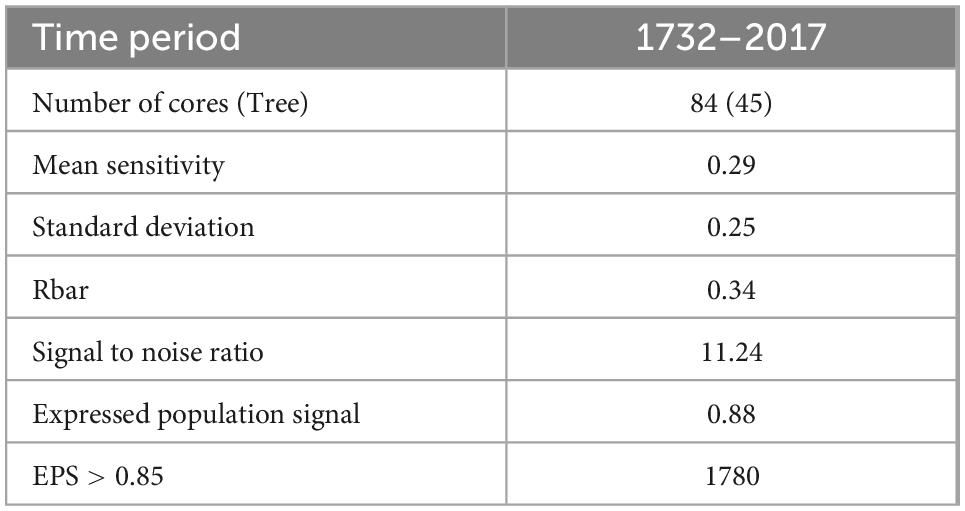Tree rings of Rhododendron arboreum portray signal of monsoon precipitation in the Himalayan region
- 1G.B. Pant National Institute of Himalayan Environment, Almora, Uttarakhand, India
- 2Birbal Sahni Institute of Palaeosciences, Lucknow, India
- 3G.B. Pant National Institute of Himalayan Environment, Sikkim Regional Centre, Pangthang, Sikkim, India
The Himalayas has a significant impact not just on the Indian subcontinent’s monsoon patterns but also on the global climate. Monsoon failure causing drought has become more common in recent years. As a result, it poses a major threat to ecosystem sustainability. We reported for the first time, a climatic-sensitive tree ring chronology of a broadleaf tree, Rhododendron arboreum, spanning 1732–2017 CE from the Himalayan region. We discovered that the climate during the monsoon season limits the growth of this tree in this region. The correlation analysis between tree ring chronology and climate revealed a significant positive relationship with precipitation (r = 0.63, p < 0.001) and a negative relationship with temperature (r = −0.48, p < 0.01) during the months of June–August (JJA). This strong relationship allowed us to reconstruct monsoon precipitation spanning 1780 to 2017 CE which explained 40% of the variance of the observed climate data for the calibration period. The reconstructed data are validated by the existence of a significant association with the gridded JJA precipitation data of the Climate Research Unit (CRU) of this region. The monsoon rainfall record captured extremely wet years during 1793, 1950, 2011, 2013, and 2017 and extremely dry years during 1812, 1833, 1996, 2002, 2004, and 2005. The extremely dry and wet years well coincided with major catastrophic historical and instrumental droughts and floods in the region. Furthermore, the reconstructed data are also validated by the significant positive correlation (r = 0.36, p < 0.001, n = 163) with the all Indian summer monsoon rainfall series. Such data will be useful to predict the incidence of future droughts, which can help to assess the vulnerability of the forest ecosystem to extreme events.
1. Introduction
Comprehending the long-term frequency and severity of drought occurrences caused by monsoon failure is critical for understanding the negative impacts on natural ecosystems, food security, the economy, society, and civilization (IPCC, 2014). The Himalayas, which have the largest snow cover outside of the South and North Poles, act as a third pole. It has a significant impact on the monsoon climate dynamics of the Indian subcontinent and other regions of the world. The major shifts in climate causing floods and droughts are linked with the rise and fall of civilizations (Kathayat et al., 2017). The potential effect of hydroclimate alterations as a result of a changing global climate creates significant issues in mountainous regions, which are a source of public concern (Tiwari et al., 2018; Valdiya, 2020; Shekhar et al., 2022). The Indian summer monsoon is connected to numerous large-scale ocean/atmospheric circulation patterns and is exacerbated under global warming scenarios (Lal, 2003; Kripalani et al., 2007; Lucas-Picher et al., 2011; Menon et al., 2013; Roxy et al., 2015; Huang et al., 2020; Sabin et al., 2020). Studies have shown that monsoon dynamics are complicated and that spatiotemporal coverage of paleoclimatic data has to be enhanced to better understand long-term changes in atmospheric circulation patterns in monsoon Asia (Kale et al., 2003; Gupta et al., 2019). To enhance knowledge of the dynamics and causes of monsoon variability in Southeast Asia, several proxies, such as tree rings, ice cores, and speleothems, have been investigated to extend climatic records (Singhvi and Kale, 2010). Tree ring width is a commonly used proxy in the Himalayan regions to reconstruct precipitation and temperature (Bhattacharyya and Yadav, 1999; Singh et al., 2006; Yadav et al., 2011; Shekhar, 2014; Shekhar et al., 2022), relative humidity (Dhyani et al., 2021b), and droughts (Cook et al., 2010; Yadav et al., 2017; Shekhar et al., 2018; Dhyani et al., 2022a). In addition, a gridded spatial reconstruction of the Palmer Drought Severity Index (PDSI) throughout Asia included building the Himalayan drought history (Cook et al., 2010). There is a lack of tree ring width data from trees sensitive to monsoon precipitation in these studies, which were largely based on tree ring analysis of conifer trees, and are suited for the study of mostly pre-monsoon temperature and precipitation (Yadav et al., 1999, 2011; Singh et al., 2006; Dhyani et al., 2022b). The ability to reconstruct monsoon precipitation from the core monsoon area is limited, owing to a lack of lengthy meteorological data to calibrate and the assumption that trees associated with generally humid or copious rainfall have weak climate-sensitive tree ring sequences (Bhattacharyya et al., 1992; Bhattacharyya and Yadav, 1999). In the Himalayan region, there are various broad-leafed tree species with unique growth rings (Gamble, 1922; Bhattacharyya and Yadav, 1999; Dhyani et al., 2021a), and their responses to climate change may vary from conifers.
However, no effort has been made to reconstruct climate using tree ring data from this broad-leafed tree from the Himalayan region. In order to fill this gap, we examined the tree rings of Rhododendron arboreum which is an essential component of subtropical to temperate forests in the Himalayas. The Rhododendron genus, as a whole, confines in a vast variety of forests from lower subtropical to alpine and extending from east to west Himalayas (Wester et al., 2019). In the Himalayas, this genus has 87 species, six of which have been identified from the Western Himalayan region (Sekar and Srivastava, 2010). It may grow in a variety of conditions, including steep zones with a lot of rain (Cox, 1990; Gibbs et al., 2011). Despite its vast range of niches from subtropical to alpine, tree ring research has been limited mostly to its shrub form in the Hindu Kush Himalaya (HKH) mountain’s tree line zone (Liang and Eckstein, 2009; Kong et al., 2012; Li et al., 2013; Bi et al., 2017). The tree ring sequence of Rhododendron spp. extends up to 400 years (Lu et al., 2015).
The objective of the present study was to develop the tree ring chronology of a broad-leafed tree Rhododendron arboreum, from the Western Himalayan region and assess its potential for hydroclimatic reconstruction and its linkages to rising temperatures and erratic monsoon precipitation as a result of global warming.
2. Materials and methods
2.1. Study area and sample collection
For the present study, the target area of Darma valley falls in an area under Pithoragarh District in Kumaun Province (290 59′ to 300 04′ N and 800 28′ to 800 57′ E). This site is located in the eastern part of the Western Himalayas (Figure 1). In this area, R. arboreum is an under-canopy medium-sized evergreen tree growing between 1,200 m and 3,000 m altitude, mostly in oak-dominated forests. We collected 84 increment cores from 45 R. arboreum trees growing at the upper approximately limit of the forest around 2,700 m in a south-facing moderate gently slope, using the dendrochronological concept that trees from the ecotone zone of forests along altitudinal range have comparatively more climatic sensitive tree rings. Considering this view, we have selected trees growing in the ecotone of temperate and subalpine forests at the study site. We have collected a minimum of two cores from each tree at a height of approximately 1.37 m, using an increment borer, preferably in the opposite direction except in some trees where other sides are rotten.
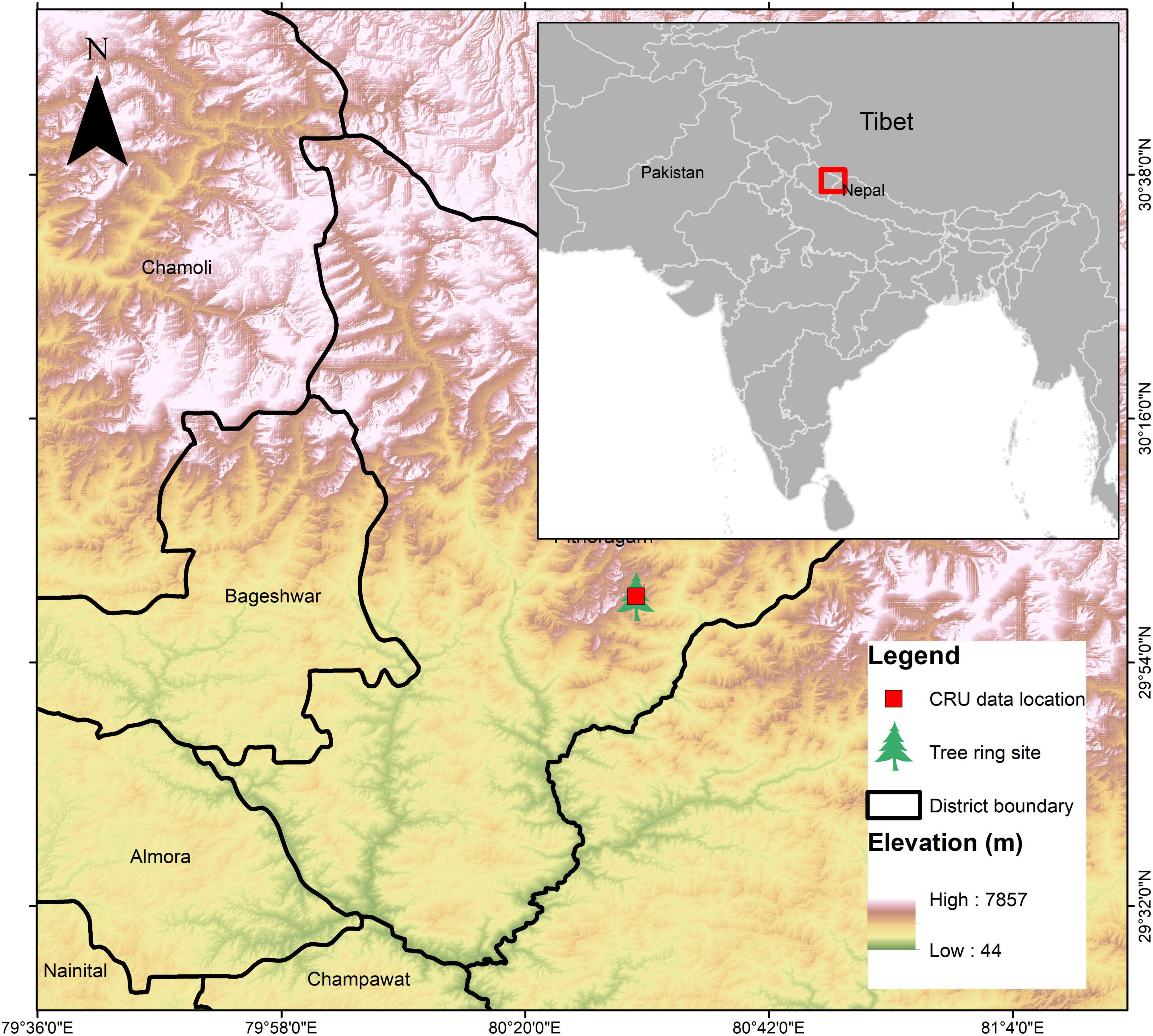
Figure 1. Map of the study sites showing tree ring sampling locations (green trees) and nearest Climate Research Unit (CRU) grid locations (red squares).
2.2. Climate data
In order to establish relationships between tree growth and climatic parameters, climate data from surrounding tree ring sites are often preferable. However, there are few meteorological stations with long records in the Himalayan region, and most of them are located distant from tree ring sampling locations. In the absence of a meteorological station at the close of the sampling site, we used g data for tree growth climate relationships that would reflect the natural habitat of Rhododendron. Monthly temperature and precipitation data from the gridded data set CRU TS version 4.01 (Harris et al., 2020) with a spatial resolution of 0.5° × 0.5° were used as a predictor for tree growth–climate response analyses for the period of 1901–2017 CE. The area receives most of its rainfall during the summer monsoon season (June–September) which contributes 70.45% of the total. The rainfall during the winter season (December–February) is quite low (Figure 2A). The annual mean temperature in the study area is 11.7°C, varying from 9–16°C in spring (MAM) to 17–17.95°C in summer (JJAS) and in winter from 3 to 5°C (Figure 2B). The higher temperature is observed during June (17.95°C) and July (17.81°C).
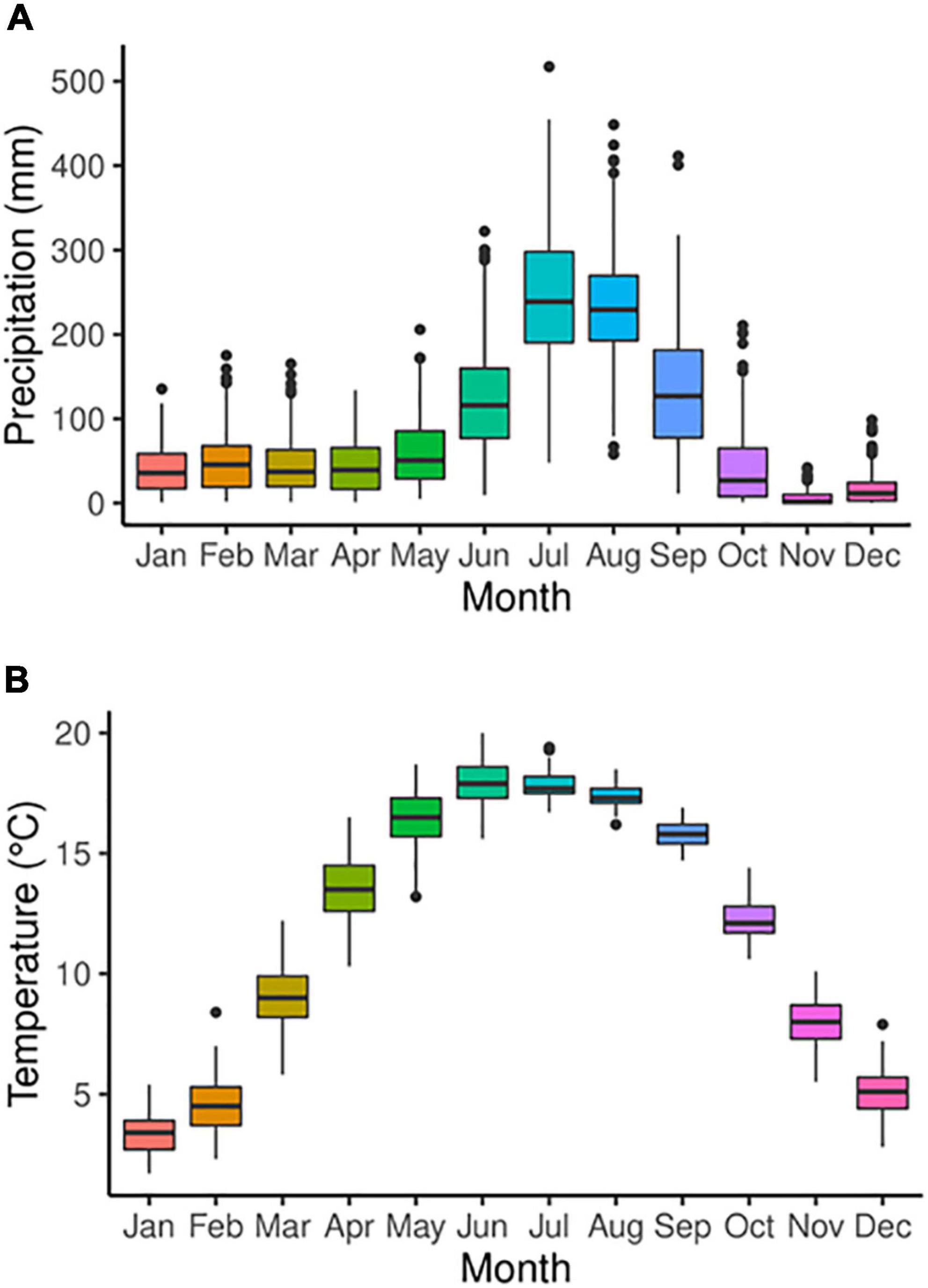
Figure 2. Boxplot showing monthly mean climate data for the region. (A) Monthly mean precipitation; (B) monthly mean temperature over the period 1902–2017.
2.3. Tree ring chronology
Samples were mounted and processed using standard procedures of tree-ring analysis. Boundaries of tree rings in R. arboreum are faint, delineated by a light line of terminal parenchyma. Thus, counting rings under a stereo-zoom microscope required careful examination. Each ring of these cores was dated to the calendar year of its formation using the cross-dating technique (Fritts, 2012). The ring widths of each dated core were measured using an increment measuring stage with 0.001 mm precision coupled with a microcomputer. Later, these measurements and dates were checked using the computer program COFECHA (Holmes, 1983; Grissino-Mayer, 2001). Cores having errors were reexamined to evaluate the source of the errors, and corrections were made. Ring-width data were standardized using the program ARSTAN (Holmes, 1983), which removes growth trends related to age and stand dynamics while retaining the maximum common signal to form tree-ring indices. For standardization, we used the cubic spline method using a cutoff of 2/3 of the time series to enhance the common climate signal in the chronology (Cook and Holmes, 1996). The variance of individual tree ring width data was stabilized using power transformation method by minimizing the heteroscedasticity before the standardization (Cook and Peters, 1997). We used residual chronology (Figure 3) that was developed using an autoregressive model by removing persistence from the raw tree ring chronology (Cook and Peters, 1997). The chronology was evaluated by several statistical parameters including mean sensitivity (MS), signal-to-noise ratio (SNR), common variance (Rbar), and low first-order autocorrelation (AC1) which are commonly used in tree ring analysis (Fritts, 2012). We also employed the Durbin-Watson statistic test in order to confirm that the residuals from the observed and reconstructed data are independent and have no autocorrelation (Fritts, 2012). The expressed population signal (EPS ≥ 0.85) was taken as an indicator of the threshold for dendroclimatic reconstruction (Wigley et al., 1984).
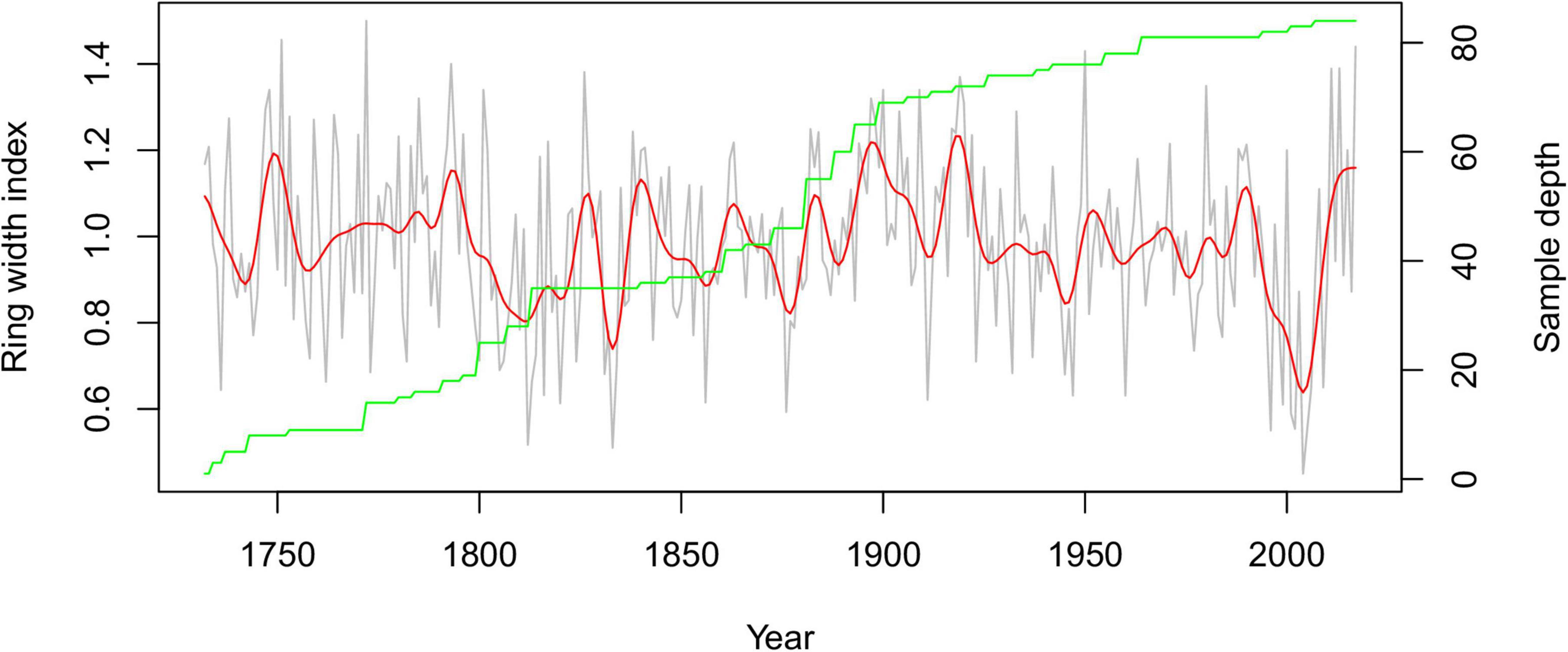
Figure 3. Ring-width index (RWI) chronology of Rhododendron arboreum from Darma valley; green line indicates sample depth, and red line plot indicates 10-year low-pass filter.
2.4. Statistical analysis
The climate-tree growth relationship was analyzed using Pearson’s correlation coefficients on a monthly basis for the identification of significant months or seasons limiting the growth of Rhododendron from the common period of tree ring chronology and climate record (1902–2017 CE). Both the stability and reliability of the regression equations were assessed using the split sample method (Fritts, 1991). These validation trials were performed by calibrating climate data from a sub-period 1902–1957 CE and verifying the reconstruction using the remaining data from 1958 to 2017 CE. The results were evaluated by the correlation coefficient (r), sign test (ST), reduction of error test (RE), product mean test (t), and coefficient of efficiency (CE) during the verification period (Fritts, 2012). The values of RE and CE greater than zero specify well model skill (Cook et al., 1999). Moreover, the values of CE are more rigorous and are typically lower than those of RE, but it is more difficult for CE values to pass the test (Cook et al., 1999). We quantified high and low precipitation here based on values greater or lesser than mean ± standard deviation (m ± 1 SD). The extreme high and low precipitation was designated based on values greater or lesser than m ± 2 SD. To analyze the cyclic behavior of reconstructed data, we performed spectrally and wavelet analysis (Grinsted et al., 2004). We also assessed the regional behavior of reconstructed data, by spatial correlation of reconstructed data with gridded Climate Research Unit (CRU TS4.02) precipitation (Harris et al., 2020) using KNMI climate explorer (Van Oldenborgh and Burgers, 2005). We also analyzed the effect of the El-Nino Southern Oscillation (ENSO) on our tree ring chronology using correlation with NINO3.4 sea surface temperatures (SSTs) and Pacific Decadal Oscillation (PDO). Moreover, we performed a 21-year moving correlation analysis with the time series of the reconstructed monsoon and NINO3.4 and PDO, respectively, to understand their long-term teleconnections. Furthermore, we made correlation analysis between the reconstructed data with all Indian summer monsoon rainfall (ISMR) to validate whether the monsoon precipitation of this site is a part of the Indian summer monsoon regime. We have also performed a regime shift analysis method to determine the timing and magnitude of regime shifts in the reconstructed data (Room et al., 2022).
3. Results
3.1. Tree ring chronology statistics
Tree ring width index (RWI) chronology of 286 years (spanning 1732–2017 CE, Figure 3) revealed a moderate MS, high SD, and high SNR and Rbar (Table 1). The value of MS (0.29) indicated low inter-annual variations. The Rbar (0.34) and EPS (0.88) values were also indicators of the reliability of this chronology for climate reconstruction. The EPS value >0.85 for the period 1780–2017 CE was considered reliable for climate reconstruction. We have not used chronology beyond 1780 CE because EPS is low due less number of samples in early part of the tree growth. By observing chronology, we noted distinct changes in tree growth patterns in recent decades. There is a declining trend during 1990–2004 CE followed by an increasing trend in recent years (Figure 3).
3.2. Tree growth and climate relationship
The growth of R. arboreum has a significant negative correlation with temperature for the months of June (r = −0.31, n = 115, p < 0.001), July (r = −0.32, n = 115, p < 0.001), and August (r = −0.34, n = 115, p < 0.001) (Figure 4A) and positive correlation with precipitation of the current year’s monsoon months June (r = 0.46, n = 115, p < 0.001), July (r = 0.39, n = 115, p < 0.001), and August (r = 0.41, n = 115, p < 0.001) (Figure 4B). The overall high correlation with precipitation during the monsoon season for the months June–August (JJA) (r = 0.63, p < 0.001) indicates its suitability for the reconstruction of precipitation.
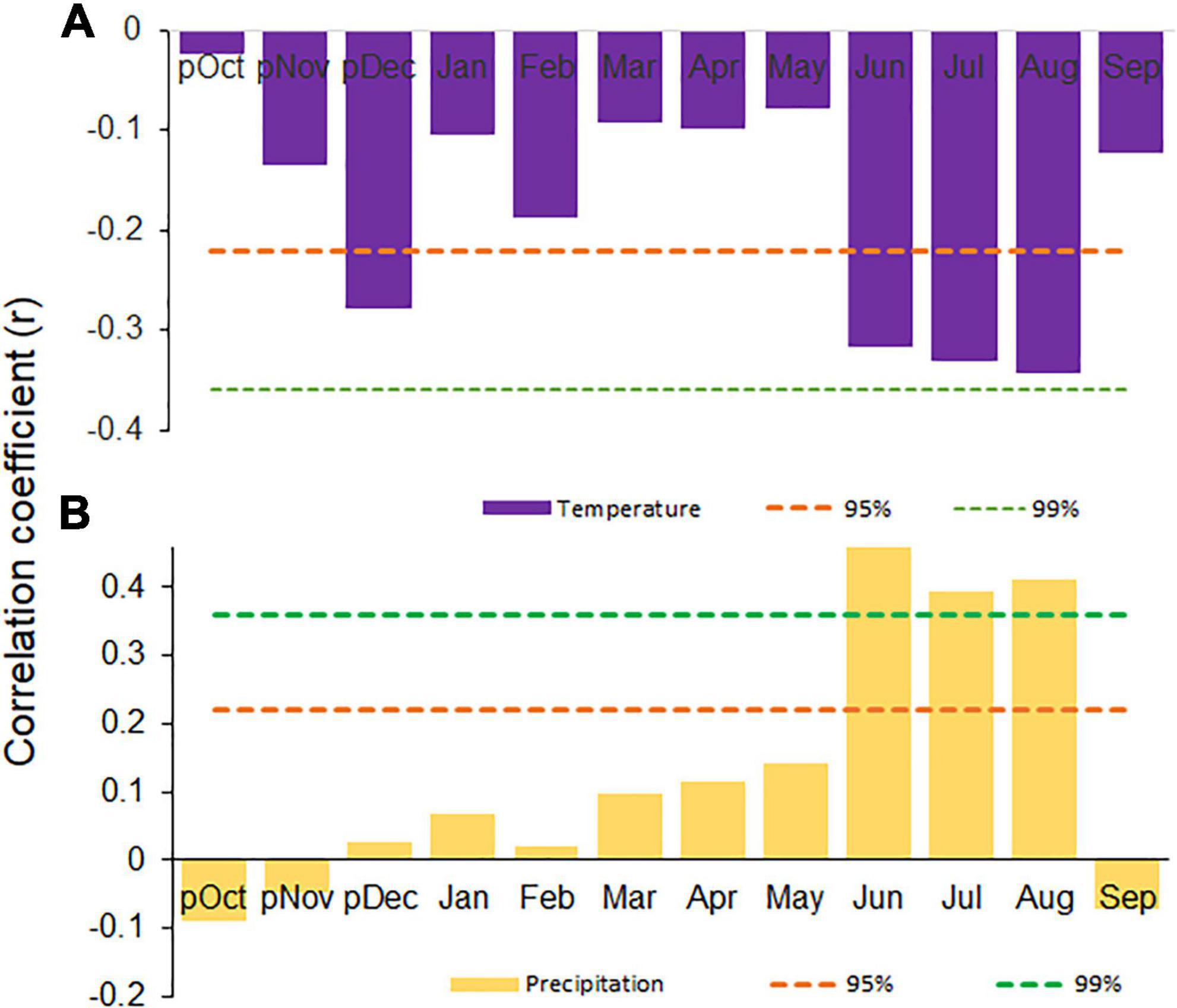
Figure 4. Pearson correlation between tree ring width chronology and climate data; (A) mean temperature (purple bar) and (B) mean precipitation (yellow bar). The red and green dotted lines indicate 95 and 99% significant confidence levels.
3.3. Extended records of monsoon precipitation
A linear model PPTJJA = 60.99 + 246.18*RWI, where PPTJJA represents reconstructed June–August precipitation, was developed and used for the reconstruction of precipitation during JJA of monsoon season since 1780 AD based on the residual tree ring chronology (Figure 5A). The regression model accounts for 40% of the variance over the calibration period from 1902 to 2017 (Figure 5B). The statistics of calibration and verification showed that model performance is reliable (Table 2). Importantly, the positive values of rigorous tests CE and RE during the verification period indicated good skills in our reconstructed data. The value of Durbin-Watson statistics shows that autocorrelation in regression model residuals is negligible. The synchronicity between actual and reconstructed data confirmed the reliability of the regression model (Figure 5B). We recorded 43 wet and 34 dry years which accounted for 18.06 and 14.28% of the total years since 1780 (Supplementary Table 1). Also, we recorded 6 (2.10%) extreme wet and 6 (2.10%) extreme dry years in the reconstructed data (Supplementary Table 1). Regime shift analysis indicated that the region experienced significant (p < 0.05) phases depicting prolonged wet conditions during the period 1780–2004 and 2011–2017 and prolonged dry conditions during 1805–1837 and 1995–2010 (Supplementary Figure 1).
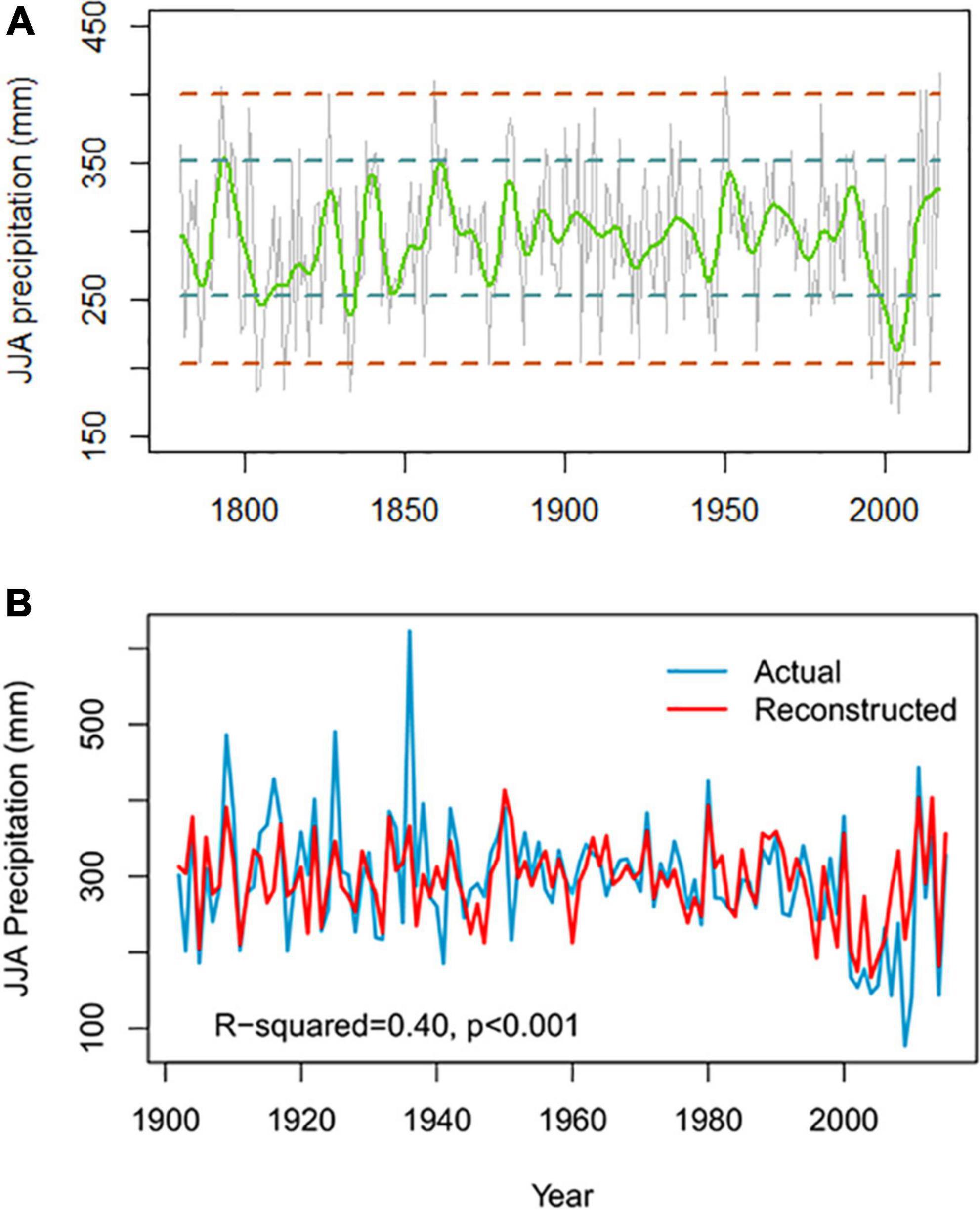
Figure 5. Reconstruction of PPTJJA in Darma, valley, Western Himalaya; (A) the reconstructed June–August (JJA) precipitation (Grey line plot) for the period 1780–2017. Dotted blue and orange line plots indicate m ± SD and m ± 2 SD of the reconstructed data. The green smoothed line indicates a 10-year low-pass filter and (B) time series of observed (blue line plot) and reconstructed (red line plot) JJA.
3.4. Spatial characteristics and teleconnections
Reconstructed precipitation shows a strong positive correlation with the ISMR data, 1900–2017 CE (r = 0.36, p < 0.001, Supplementary Figure 2A), which indicates that the site is under the regional impact of the Indian summer monsoon. The spatial correlation analysis between reconstructed PPTJJA with gridded JJA precipitation over the western and central parts of the Indian Himalayas exhibited a significant positive correlation (p < 0.05) during the period 1902–2017 (Figure 6). Such coherence in records represents a regional behavior of monsoon precipitation covering a wider area in the Himalayan region. Moreover, wavelet analysis identified significant high-frequency cycles ranging from 2–8 years to 16–32 years (Figure 7). Furthermore, a significant negative correlation (r = −0.16, p < 0.05, Supplementary Figure 2B) with June–August NINO3.4 SSTs for the period 1900–2017 CE and June–August PDO (r = −0.19, p < 0.05, Supplementary Figure 2C) during 1850–2017 indicate a long-term effect of ENSO and PDO over the monsoon variability at this region. The 21-year moving correlation analysis between NINO3.4 and PDO each with the reconstructed JJA precipitation shows a distinct pattern of correlation at some intervals (Supplementary Figure 3). For NINO3.4, a significant negative correlation was observed during 1900–1943 (r = −0.47, p < 0.05, Supplementary Figure 3) and 1946–1971 (r = −0.42, p < 0.05, Supplementary Figure 3). For other time intervals, we did not find any significant correlations. In the case of PDO, a significant negative correlation was observed for the periods 1940–1971 (r = −0.43, p < 0.05, Supplementary Figure 3) and 1957–1981 (r = −0.48, p < 0.05, Supplementary Figure 3).
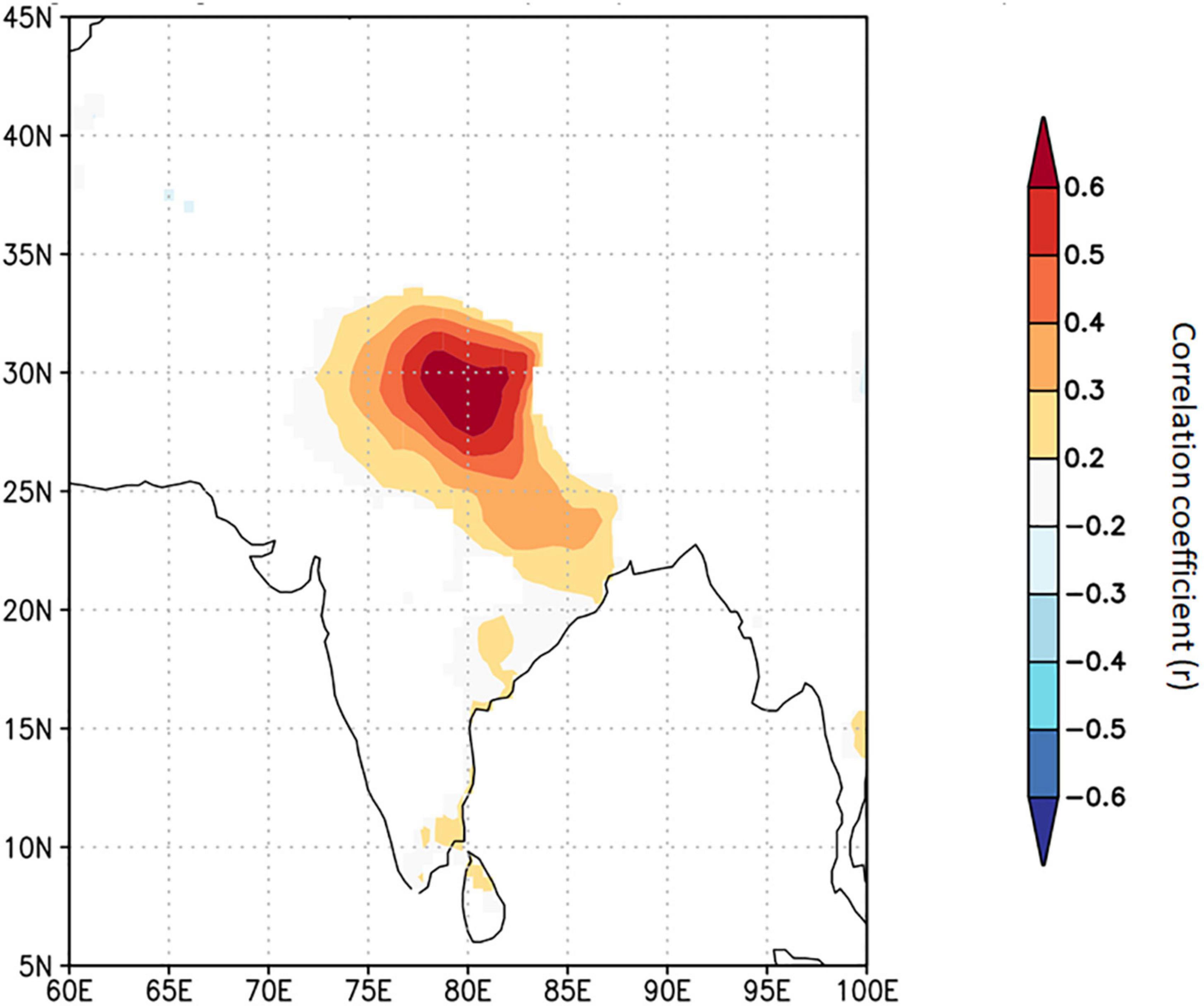
Figure 6. Spatial correlation of the reconstructed PPTJJA with gridded CRU JJA precipitation during the period 1902–2017.
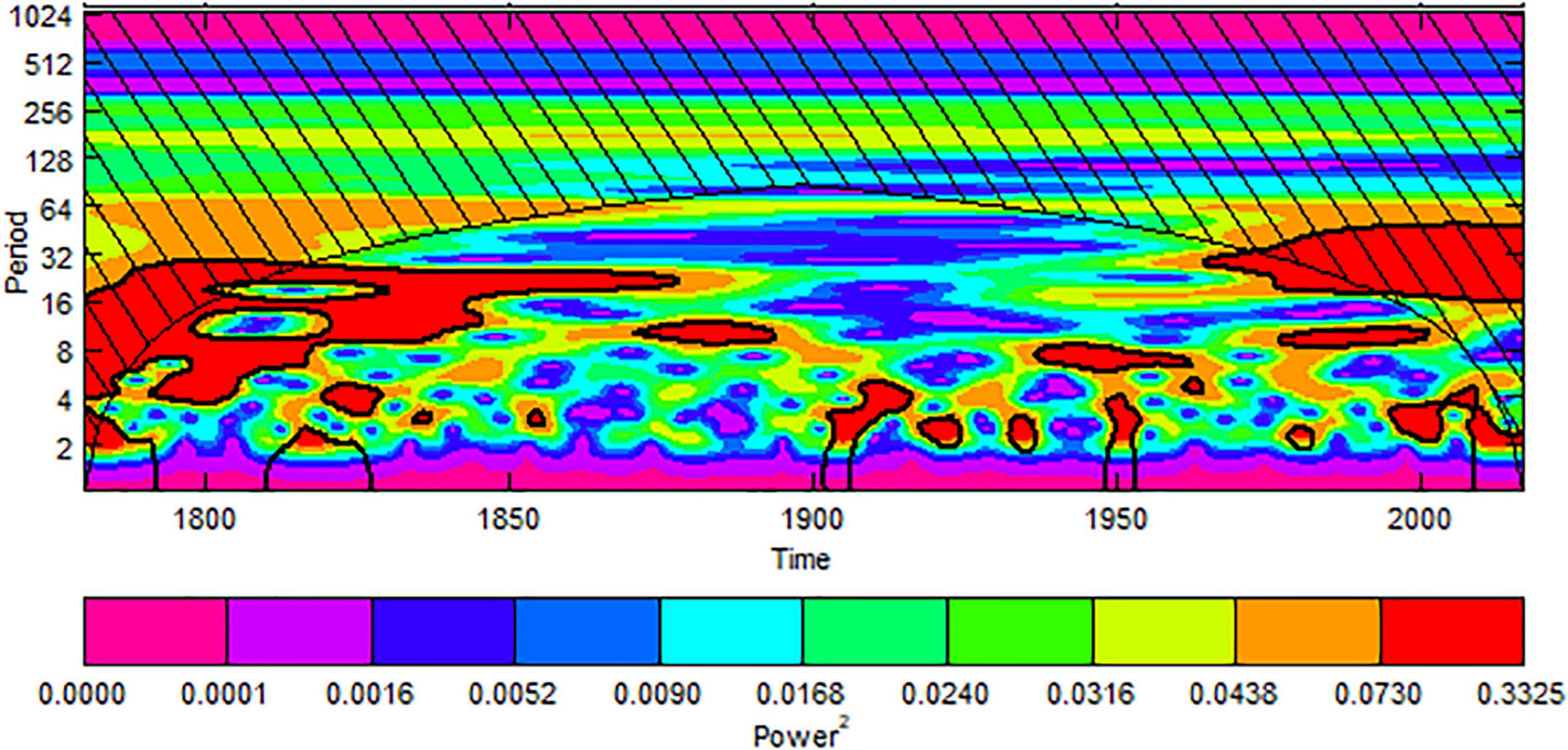
Figure 7. Morlet wavelet spectrum with a high edge effect and a red-noise background at 95% confidence level (black lines/contours) for reconstructed PPTJJA.
4. Discussion
4.1. Growth/climate response of R. arboreum
Through dendroclimatic analysis of the R. arboreum tree, growing in Drama valley, Western Himalaya, we established the potentiality of this broad-leaved tree in the reconstruction of the monsoon precipitation. It is so far, the longest tree ring record of Rhododendron that showed evidence of sensitivity to summer monsoon season. This is evident with the existence of significant positive correlations with precipitation (JJA) and an inverse relationship with the temperature of the same months. The earlier tree ring analyses of Rhododendron species were on its shrub form growing in the Tibetan plateau and central Himalayas (Liang and Eckstein, 2009; Lu et al., 2015; Bi et al., 2017; Panthi et al., 2017). Regarding the response to climate, the mean temperature of July, irrespective of slope aspects, and elevations play a key role in controlling wood formation in the Tibetan plateau (Frank et al., 2005; Leal et al., 2007; Hallinger et al., 2010; Blok et al., 2011; Weijers et al., 2012; Lu et al., 2015). In the central Himalayas, increased minimum winter temperatures have a significant role in the growth of this taxon (Panthi et al., 2021). However, our results are not consistent with these findings. Tree growth response to climate changes is differing from site to site due to differences in life forms (tree/shrub), species, geographical locations, and elevation differences. Tree growth climate relationship recorded in the present study, however, showed some consistency in climatic response with Rhododendron aganniphum shrub growing at the 4,000–4,500 m of the Tibetan plateau where it also shows a similar favorable response to July month’s precipitation though it is not statistically significant (Lu et al., 2015). We recorded in R. arboreum that the increased temperature during the monsoon season is detrimental to its growth in the temperate belt of the western Indian Himalayan region. During the JJA months, both temperature and precipitation are at their highest in this region. Thus, a rise in temperature during these months might limit photosynthesis by increasing evapotranspiration. It appears that the increased summer precipitation and low temperature in the Himalayan region promote the growth of Rhododendron. This also supports the current spatial distribution of 127 species in the Indian Himalayan region. A greater concentration (98%) of species is confined to the cool moist part of the North-East in comparison to the drier western part (Mao, 2010), indicating a preference for cool-moist environments.
4.2. Salient features of reconstructed PPTJJA
The present study is a maiden attempt to derive a reliable 238-year (1780–2017) summer monsoon precipitation record from the Western Himalayan region. This reconstruction provides a long-term drought variability and captured extreme events that are also witnessed in the historical records. In the recent past, the region exhibited a rapid and extended dry period from 1995 to 2010, which is consistent with the recent decadal decrease in tree ring-based rainfall reconstruction in the Western Himalayan region (Sano et al., 2012, 2017; Xu et al., 2018) and even in climatic assessment based on meteorological data (Roxy et al., 2015). However, in recent decades, we observed an increase in rainfall patterns that was not captured by earlier studies. This inconsistency may be due to the Himalayan region’s distinct sources and seasonal distribution of precipitation. The decreased monsoon locations seem to be more influenced by the increased snow cover than the present study sites. During the monsoon season, years with high snowfall in the preceding winter and spring are followed by summer with less monsoon rain (Blanford, 1884; Bamzai and Kinter, 1997). This is further reinforced by the idea that greater wetness in the northwestern Himalayas has influenced anomalous glacier progress in recent years and that increasing snowfall may contribute to dry conditions in summer (Yadav et al., 2017; Ahmad et al., 2020). Interestingly, since 2010, an increase in Indian summer rainfall has been reported in several gridded and observed datasets throughout the Indian subcontinent (Jin and Wang, 2017). This increase in summer monsoon precipitation has been linked to greater thermal contrast between land and ocean, as seen by a faster warming rate across the Indian subcontinent compared with a slower warming rate over the Indian Ocean (Jin and Wang, 2017). On the contrary, due to the rapid warming of the Indian Ocean, the land-sea thermal contrast weaken, and a significant reducing trend of summer monsoon during 1995-2010 was caused. The extreme droughts of the Indian summer monsoon years 2002 and 20041 are consistent with our reconstructed data. Singh et al. (2019) also from the central Himalayan region reported the severe droughts of 2002 and 2004. The major extreme wet years in 2013 and 2017 are also consistent with regional floods that happened in Kumaun which caused catastrophic damage and devastation in the region. We have noticed that several key prolonged dry and wet conditions in the reconstructed monsoon records are correlated with the other tree ring proxy-based reconstructions from the Himalayan region. A significant positive correlation of our reconstructed PPTJJA with reconstructed JJA PDSI (r = 0.20, p < 0.001) from monsoon Asia during the period 1780–2005 (Cook et al., 2010) and May–September precipitation (r = 0.14, p < 0.05) from Bhutan Himalaya (Sano et al., 2013) during the period 1780–2011 further indicates regional linkages. The late 18th century droughts from 1785 to 1794s in JJA PDSI (Cook et al., 2010), March–September precipitation (Sano et al., 2013), March–September PDSI (Ahmad et al., 2020), and March–July precipitation (Singh et al., 2009), as well as historical East India Drought (1790–1796), are also common in our reconstructed precipitation data (Figure 8). Similarly, the dry episodes of 1830–1836 synchronize with May–September precipitation reconstruction (Sano et al., 2013). The other common dry phase of 1865–1875 in March–September PDSI (Ahmad et al., 2020), MS precipitation (Sano et al., 2013), May–June PDSI (He et al., 2018), and the previous year October to current year September precipitation reconstruction (Singh et al., 2021) are also more or less synchronized with our reconstruction. Since last three decades, late 1995–2004s drought phase (Sano et al., 2013; Singh et al., 2021) and drought records (Cook et al., 2010) are also congruent with our study. The wet phase after 2010 was well coincide with May–September precipitation records from Bhutan Himalaya (Sano et al., 2013). The historical East India Drought (1790–1796) is also common with the reconstructed low monsoon precipitation data (Cook et al., 2010). Such coherence in drought events are observed at some intervals in these studies, even when sites are not from under similar climatic zones and use of different climatic proxies. Such coherence may be a role of upper atmospheric circulation affecting both monsoon and western disturbance. We observed that the calibration period (1905–1957) was unable to capture extreme event years. These extreme values were underestimated in tree ring calibrations, because of precipitation beyond a threshold value are not always possible to retrieve from tree rings (Singh et al., 2009; Yadav, 2011). Moreover, according to wavelet analysis, the cyclicity of 2–4 and 16–32 years is likely to be associated with ENSO and PDO which is also found in moving correlation analysis between reconstructed PPTJJA with ENSO and PDO (Figure 6). It indicates that PPTJJA changes in our study area have teleconnections with large-scale atmospheric circulation systems. Interestingly, the severe drought occurrences of 2009 coincided with the same El-Nino year; nevertheless, other extreme drought years, such as 2005 and 2006, correspond to the preceding El-Nino event years of 2004 and 2005, respectively. This might be due to the lag effect of tree growth in relation to climate. Extreme wet/dry growth years are often recorded to follow with years of wide/narrow tree rings due to role of stored food in trees. Stored food effect subsidized the impact of El-Nino in the same year but its role of deficient rainfall in reducing photosynthesis felt in the following year. To increase our knowledge of Asian monsoon dynamics, we need a better understanding of the spatial and temporal variability of precipitation in the Himalayas.
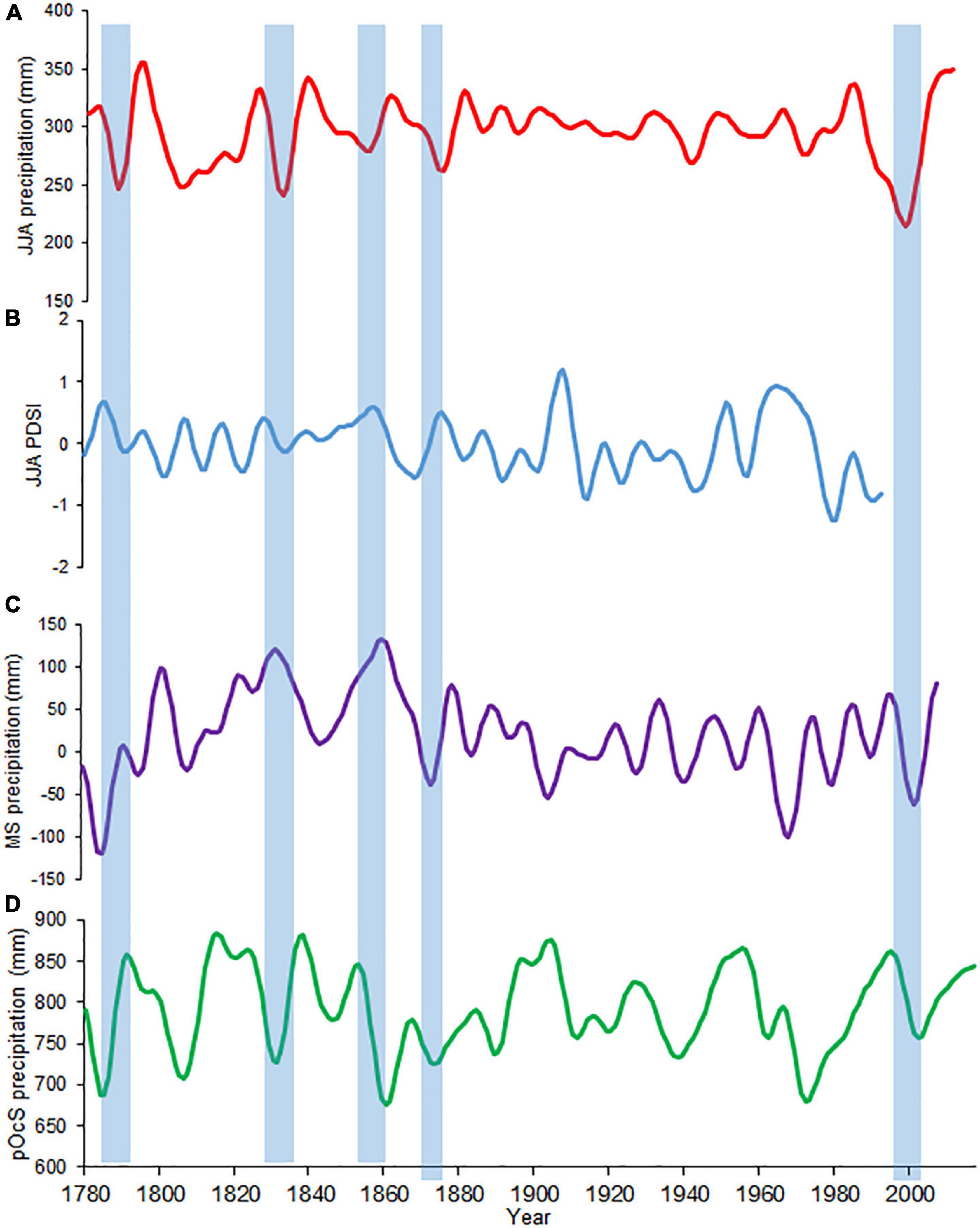
Figure 8. Comparison of (A) reconstructed PPTJJA with (B) JJA PDSI reconstruction from Asia (Cook et al., 2010), (C) May–September (MS) precipitation reconstruction from Bhutan Himalaya (Sano et al., 2013), and (D) previous October–Current September (pOcS) precipitation reconstruction from Indian Western Himalaya (Singh et al., 2021). All the line plots are smoothed by a 10-year low-pass smoothing filter.
5. Conclusion
Tree ring width data of the broad-leaved R. arboreum tree (spanning 1780–2017 CE) was analyzed first time from the core monsoon region of the Himalayas. We recorded that the chronology of this tree is the potential for the reconstruction of monsoon (JJA) precipitation. The extended precipitation data not only provided information on long-term drought variability but also captured extreme events. With the absence of a sufficient long monsoon record in the Himalayan region, the present database would help improving in the understanding of regional climate models, especially variability in monsoon precipitation. Moreover, the biogeographical point of view of this study has great relevance, providing insight into the growth behavior of the temperate tree, Rhododendron in relation to monsoon precipitation. This information would be helpful to policymakers in taking adaptation measures in forest management to protect the marginal communities of the Himalayan region from the anticipated adverse impacts of future droughts. We observed that the great altitudinal distributional range of Rhododendron spp. would be ideal for dendroclimatic analyses for the understanding of diversified aspects of seasonal climate changes in the Himalayan region. The presence of shrub form, Rhododendron Campanulatum, above 3,500 m altitude at the present study site would be useful to analyze climatic factors governing its growth at its upper limit close to the snow line. Thus, a detailed study using multiple tree-ring chronologies of Rhododendron species from a wider altitudinal range, as well as combined with geomorphological, glacial mass balance records, and other evidence, would provide a better database to quantify tree growth/monsoon climate/glacial relationships over a longer timescale from the Himalayan region.
Data availability statement
The raw data supporting the conclusions of this article will be made available by the authors, without undue reservation.
Author contributions
RD: data creation, visualization, and writing—original draft. RD and MS: formal analysis. RD, RJ, MS, and AB: investigation. JC, PS, RD, and AB: methodology. RJ, RD, AB, MS, JC, and PS: writing—review and editing. All authors contributed to investigation, writing—review and editing, read, and agreed to the published version of the manuscript.
Funding
The financial support provided by the Department of Science and Technology, Government of India under NMSHETF3 (Phase-II) is highly acknowledged.
Acknowledgments
We are thankful to the Director, NIHE for providing facilities in the institute which could make the present study possible. We also thank the Forest Department, Government of Uttarakhand for providing necessary permission during the collection of tree–ring samples. AB and MS express gratitude to the Director BSIP, Lucknow for providing laboratory facilities and permission to carry out this collaborative research study.
Conflict of interest
The authors declare that the research was conducted in the absence of any commercial or financial relationships that could be construed as a potential conflict of interest.
Publisher’s note
All claims expressed in this article are solely those of the authors and do not necessarily represent those of their affiliated organizations, or those of the publisher, the editors and the reviewers. Any product that may be evaluated in this article, or claim that may be made by its manufacturer, is not guaranteed or endorsed by the publisher.
Supplementary material
The Supplementary Material for this article can be found online at: https://www.frontiersin.org/articles/10.3389/ffgc.2022.1044182/full#supplementary-material
Footnotes
References
Ahmad, S., Zhu, L., Yasmeen, S., Zhang, Y., Li, Z., Ullah, S., et al. (2020). A 424-year tree-ring-based palmer drought severity index reconstruction of Cedrus deodara D. don from the hindu kush range of Pakistan: Linkages to ocean oscillations. Clim. Past 16, 783–798. doi: 10.5194/cp-16-783-2020
Bamzai, A., and Kinter, J. (1997). Climatology and interannual variability of Northern Hemisphere snow cover and depth based on satellite observations. Kanagawa: Institute of Global Environment.
Bhattacharyya, A., LaMarche, V. Jr., and Hughes, M. (1992). Tree-ring chronologies from Nepal. Tree Ring Bull. 52, 59–66.
Bhattacharyya, A., and Yadav, R. (1999). Climatic reconstructions using tree-ring data from tropical and temperate regions of India-a review. IAWA J. Brill 20, 311–316. doi: 10.1163/22941932-90000693
Bi, Y., Xu, J., Yang, J., Li, Z., Gebrekirstos, A., Liang, E., et al. (2017). Ring-widths of the above tree-line shrub Rhododendron reveal the change of minimum winter temperature over the past 211 years in Southwestern China. Clim. Dyn. 48, 3919–3933. doi: 10.1007/s00382-016-3311-4
Blanford, H. II (1884). On the connexion of the Himalaya snowfall with dry winds and seasons of drought in India. Proc. R. Soc. Lond. 37, 3–22. doi: 10.1098/rspl.1884.0003
Blok, D., Sass-Klaassen, U., Schaepman-Strub, G., Heijmans, M., Sauren, P., and Berendse, F. (2011). What are the main climate drivers for shrub growth in Northeastern Siberian tundra? Biogeosciences 8, 1169–1179. doi: 10.5194/bg-8-1169-2011
Cook, E., Anchukaitis, K., Buckley, B., D’Arrigo, R., Jacoby, G., and Wright, W. (2010). Asian monsoon failure and megadrought during the last millennium. Science 328, 486–489. doi: 10.1126/science.1185188
Cook, E., and Holmes, R. (1996). Guide for computer program arstan. Int. Tree Ring Data Bank Prog. Lib. Vers. 2, 75–87.
Cook, E., Meko, D., Stahle, D., and Cleaveland, M. (1999). Drought reconstructions for the continental United States. J. Clim. 12, 1145–1162. doi: 10.1175/1520-0442(1999)012<1145:DRFTCU>2.0.CO;2
Cook, E., and Peters, K. (1997). Calculating unbiased tree-ring indices for the study of climatic and environmental change. Holocene 7, 361–370. doi: 10.1177/095968369700700314
Dhyani, R., Shekhar, M., Joshi, R., Bhattacharyya, A., Ranhotra, P., Pal, A., et al. (2021b). Reconstruction of pre-monsoon relative humidity since 1800 C.E. based on tree-ring data of Pinus roxburghii sarg. (chir–pine) from Pithoragarh, Western Himalaya. Q. Int. 629, 4–15. doi: 10.1016/j.quaint.2021.04.026
Dhyani, R., Bhattacharyya, A., and Rawal, R. (2021a). The oldest Birch tree in the Western Himalaya depicting signature of major climatic events of the recent era in its tree rings. Curr. Sci. 121, 350–353.
Dhyani, R., Bhattacharyya, A., Singh Rawal, R., Joshi, R., Shekhar, M., and Singh Ranhotra, P. (2022a). Is tree ring chronology of blue pine (Pinus wallichiana A. B. Jackson) prospective for summer drought reconstruction in the Western Himalaya? J. Asian Earth Sci. 229:105142. doi: 10.1016/j.jseaes.2022.105142
Dhyani, R., Joshi, R., Ranhotra, P., Shekhar, M., and Bhattacharyya, A. (2022b). Age dependent growth response of Cedrus deodara to climate change in temperate zone of western himalaya. Trees For. People 8:100221. doi: 10.1016/j.tfp.2022.100221
Frank, D., Wilson, R., and Esper, J. (2005). Synchronous variability changes in alpine temperature and tree-ring data over the past two centuries. Boreas 34, 498–505. doi: 10.1080/03009480500231443
Fritts, H. (1991). Reconstructing large-scale climatic patterns from tree-ring data: T diagnostic analysis. Arizona: University of Arizona Press.
Gamble, J. (1922). A manual of Indian timbers: An account of the growth, distribution, and uses of the trees and shrubs of India and Ceylon, with descriptions of their wood-structure. London: S. Low, Marston & Company Limited.
Gibbs, D., Chamberlain, D., and Argent, G. (2011). The red list of Rhododendrons. Richmond, UK: Botanic Gardens Conservation International.
Grinsted, A., Moore, J., and Jevrejeva, S. (2004). Application of the cross wavelet transform and wavelet coherence to geophysical time series. Nonlinear Process. Geophys. 11, 561–566. doi: 10.5194/npg-11-561-2004
Grissino-Mayer, H. (2001). Evaluating crossdating accuracy: A manual and tutorial for the computer program cofecha. Tree Ring Soc. 57, 205–221.
Gupta, A., Negi, M., Nandy, S., Alatalo, J., Singh, V., and Pandey, R. (2019). Assessing the vulnerability of socio-environmental systems to climate change along an altitude gradient in the Indian Himalayas. Ecol. Indicat. 106:105512. doi: 10.1016/j.ecolind.2019.105512
Hallinger, M., Manthey, M., and Wilmking, M. (2010). Establishing a missing link: Warm summers and winter snow cover promote shrub expansion into alpine tundra in Scandinavia. New Phytol. 186, 890–899. doi: 10.1111/j.1469-8137.2010.03223.x
Harris, I., Osborn, T., Jones, P., and Lister, D. (2020). Version 4 of the CRU TS monthly high-resolution gridded multivariate climate dataset. Sci. Data 7, 1–18. doi: 10.1038/s41597-020-0453-3
He, M., Bräuning, A., Grießinger, J., Hochreuther, P., and Wernicke, J. (2018). May–June drought reconstruction over the past 821 years on the south-central Tibetan Plateau derived from tree-ring width series. Dendrochronologia 47, 48–57. doi: 10.1016/j.dendro.2017.12.006
Holmes, R. (1983). Computer-assisted quality control in tree-ring dating and measurement. Tree Ring Bull. 43, 69–78.
Huang, X., Zhou, T., Turner, A., Dai, A., Chen, X., Clark, R., et al. (2020). The recent decline and recovery of indian summer monsoon rainfall: Relative roles of external forcing and internal variability. J. Clim. 33, 5035–5060. doi: 10.1175/JCLI-D-19-0833.1
IPCC (2014). “Mitigation of climate change,” in Contribution of working group III to the fifth assessment report of the intergovernmental panel on climate change, eds O. Edenhofer, R. Pichs-Madruga, Y. Sokona, E. Farahani, S. Kadner, K. Seyboth, et al. (Cambridge, MA: Cambridge University Press), 1454.
Jin, Q., and Wang, C. (2017). A revival of Indian summer monsoon rainfall since 2002. Nat. Clim. Change 7, 587–594. doi: 10.1038/nclimate3348
Kale, V., Gupta, A., and Singhvi, A. (2003). “Late Pleistocene–Holocene Palaeohydrology of Monsoon Asia,” in Palaeohydrology: Understanding global change, eds K. J. Gregory and G. Benito (Hoboken, NJ: Wiley), 213.
Kathayat, G., Cheng, H., Sinha, A., Yi, L., Li, X., Zhang, H., et al. (2017). The indian monsoon variability and civilization changes in the indian subcontinent. Sci. Adv. 3:e1701296. doi: 10.1126/sciadv.1701296
Kong, G., Luo, T., Liu, X., Zhang, L., and Liang, E. (2012). Annual ring widths are good predictors of changes in net primary productivity of alpine Rhododendron shrubs in the Sergyemla Mountains, southeast Tibet. Plant Ecol. 213, 1843–1855. doi: 10.1007/s11258-012-0140-3
Kripalani, R., Oh, J., Kulkarni, A., Sabade, S., and Chaudhari, H. (2007). South Asian summer monsoon precipitation variability: Coupled climate model simulations and projections under IPCC AR4. Theor. Appl. Climatol. 90, 133–159. doi: 10.1007/s00704-006-0282-0
Lal, M. (2003). Global climate change: India’s monsoon and its variability. J. Environ. Stud. Policy 6, 1–34.
Leal, S., Melvin, T., Grabner, M., Wimmer, R., and Briffa, K. (2007). Tree-ring growth variability in the Austrian Alps: The influence of site, altitude, tree species and climate. Boreas 36, 426–440. doi: 10.1080/03009480701267063
Li, Z., Liu, G., Fu, B., Zhang, Q., Ma, K., and Pederson, N. (2013). The growth-ring variations of alpine shrub Rhododendron przewalskii reflect regional climate signals in the alpine environment of Miyaluo Town in Western Sichuan Province, China. Acta Ecol. Sin. 33, 23–31. doi: 10.1016/j.chnaes.2012.12.004
Liang, E., and Eckstein, D. (2009). Dendrochronological potential of the alpine shrub Rhododendron nivale on the south-eastern Tibetan Plateau. Ann. Bot. 104, 665–670. doi: 10.1093/aob/mcp158
Lu, X., Camarero, J., Wang, Y., Liang, E., and Eckstein, D. (2015). Up to 400-year-old Rhododendron shrubs on the southeastern tibetan plateau: Prospects for shrub-based dendrochronology. Boreas 44, 760–768. doi: 10.1111/bor.12122
Lucas-Picher, P., Christensen, J., Saeed, F., Kumar, P., Asharaf, S., Ahrens, B., et al. (2011). Can regional climate models represent the Indian monsoon? J. Hydrometeorol. 12, 849–868. doi: 10.1175/2011JHM1327.1
Mao, A. (2010). The genus Rhododendron in north-east India. Bot. Orient. 7, 26–34. doi: 10.3126/botor.v7i0.4370
Menon, A., Levermann, A., Schewe, J., Lehmann, J., and Frieler, K. (2013). Consistent increase in Indian monsoon rainfall and its variability across CMIP-5 models. Earth Syst. Dyn. 4, 287–300. doi: 10.5194/esd-4-287-2013
Panthi, S., Bräuning, A., Zhou, Z., and Fan, Z. (2017). Tree rings reveal recent intensified spring drought in the central Himalaya. Nepal. Glob. Planet. Change 157, 26–34. doi: 10.1016/j.gloplacha.2017.08.012
Panthi, S., Fan, Z., and Bräuning, A. (2021). Ring widths of Rhododendron shrubs reveal a persistent winter warming in the central Himalaya. Dendrochronologia 65:125799. doi: 10.1016/j.dendro.2020.125799
Room, A., Franco-Gaviria, F., and Urrego, D. (2022). rshift STARS manual-regime shift analysis for paleoecological data v2.1.1.
Roxy, M., Ritika, K., Terray, P., Murtugudde, R., Ashok, K., and Goswami, B. (2015). Drying of Indian subcontinent by rapid Indian Ocean warming and a weakening land-sea thermal gradient. Nat. Commun. 6:7423. doi: 10.1038/ncomms8423
Sabin, T., Krishnan, R., Vellore, R., Priya, P., Borgaonkar, H., Singh, B., et al. (2020). “Climate Change Over the Himalayas,” in Assessment of climate change over the indian region: A report of the ministry of earth sciences (MoES), Government of India, eds R. Krishnan, J. Sanjay, C. Gnanaseelan, M. Mujumdar, A. Kulkarni, and S. Chakraborty (Singapore: Springer), 207–222. doi: 10.1007/978-981-15-4327-2_11
Sano, M., Dimri, A., Ramesh, R., Xu, C., Li, Z., and Nakatsuka, T. (2017). Moisture source signals preserved in a 242-year tree-ring δ18O chronology in the western Himalaya. Glob. Planet. Change 157, 73–82. doi: 10.1016/j.gloplacha.2017.08.009
Sano, M., Ramesh, R., Sheshshayee, M., and Sukumar, R. (2012). Increasing aridity over the past 223 years in the Nepal Himalaya inferred from a tree-ring δ18O chronology. Holocene 22, 809–817. doi: 10.1177/0959683611430338
Sano, M., Tshering, P., Komori, J., Fujita, K., Xu, C., and Nakatsuka, T. (2013). May–September precipitation in the Bhutan Himalaya since 1743 as reconstructed from tree ring cellulose δ18O. J. Geophys. Res. 118, 8399–8410. doi: 10.1002/jgrd.50664
Sekar, K., and Srivastava, S. (2010). Rhododendrons in Indian Himalayan region: Diversity and conservation. Am. J. Plant Sci. 1:131. doi: 10.4236/ajps.2010.12017
Shekhar, M. (2014). Application of multi-proxy tree-ring parameters in the reconstruction of climate vis-a-vis ‘glacial fluctuation from the eastern Himalaya. Ph.D thesis. Lucknow: Department of Botnay, University of Lucknow.
Shekhar, M., Pal, A., Bhattacharyya, A., Ranhotra, P., and Roy, I. (2018). Tree-ring based reconstruction of winter drought since 1767 CE from Uttarkashi, Western Himalaya. Q. Int. 479, 58–69. doi: 10.1016/j.quaint.2017.08.029
Shekhar, M., Ranhotra, P., Bhattacharyya, A., Singh, A., Dhyani, R., and Singh, S. (2022). “Tree-Ring-Based Hydrological Records Reconstructions of the Himalayan Rivers: Challenges and Opportunities,” in Climate change: Impacts, responses and sustainability in the Indian Himalaya, eds S. Rani and R. Kumar (Cham: Springer International Publishing), 47–72. doi: 10.1007/978-3-030-92782-0_3
Singh, J., Park, W., and Yadav, R. (2006). Tree-ring-based hydrological records for western Himalaya, India, since AD 1560. Clim. Dyn. 26, 295–303. doi: 10.1007/s00382-005-0089-1
Singh, J., Singh, N., Chauhan, P., Yadav, R., Bräuning, A., Mayr, C., et al. (2019). Tree-ring δ18O records of abating June–July monsoon rainfall over the Himalayan region in the last 273 years. Q. Int. 532, 48–56. doi: 10.1016/j.quaint.2019.09.030
Singh, J., Yadav, R., and Wilmking, M. (2009). A 694-year tree-ring based rainfall reconstruction from Himachal Pradesh. India. Clim. Dyn. 33, 1149–1158. doi: 10.1007/s00382-009-0528-5
Singh, V., Misra, K., Singh, A., Yadav, R., and Yadava, A. (2021). Little ice age revealed in tree-ring-based precipitation record from the Northwest Himalaya, India. Geophys. Res. Lett. 48:e2020GL091298. doi: 10.1029/2020GL091298
Singhvi, A., and Kale, V. (2010). Paleoclimate studies in India: Last ice age to the present. New Delhi: Indian National Science Acad.
Tiwari, S., Kar, S., and Bhatla, R. (2018). Mid-21st century projections of hydroclimate in Western Himalayas and Satluj River basin. Glob. Planet. Change 161, 10–27. doi: 10.1016/j.gloplacha.2017.10.013
Valdiya, K. (2020). Anomalous weather events in central Himalaya: Real-world observations and some questions. Curr. Sci. 119, 19–25. doi: 10.18520/cs/v119/i1/19-25
Van Oldenborgh, G., and Burgers, G. (2005). Searching for decadal variations in ENSO precipitation teleconnections. Geophys. Res. Lett. 32, 1–2. doi: 10.1029/2005GL023110
Weijers, S., Greve Alsos, I., Bronken Eidesen, P., Broekman, R., Loonen, M., and Rozema, J. (2012). No divergence in Cassiope tetragona: Persistence of growth response along a latitudinal temperature gradient and under multi-year experimental warming. Ann. Bot. 110, 653–665. doi: 10.1093/aob/mcs123
Wester, P., Mishra, A., Mukherji, A., and Shrestha, A. (2019). The Hindu Kush Himalaya assessment: Mountains, climate change, sustainability and people. Berlin: Springer. doi: 10.1007/978-3-319-92288-1
Wigley, T., Briffa, K., and Jones, P. (1984). On the average value of correlated time series, with applications in dendroclimatology and hydrometeorology. J. Appl. Meteorol. Climatol. 23, 201–213. doi: 10.1175/1520-0450(1984)023<0201:OTAVOC>2.0.CO;2
Xu, C., Sano, M., Dimri, A., Ramesh, R., Nakatsuka, T., Shi, F., et al. (2018). Decreasing Indian summer monsoon on the northern Indian sub-continent during the last 180 years: Evidence from five tree-ring cellulose oxygen isotope chronologies. Clim. Past 14, 653–664. doi: 10.5194/cp-14-653-2018
Yadav, R. (2011). Tree ring evidence of a 20th century precipitation surge in the monsoon shadow zone of the western Himalaya, India. J. Geophys. Res. 116:D02112. doi: 10.1029/2010JD014647
Yadav, R., Braeuning, A., and Singh, J. (2011). Tree ring inferred summer temperature variations over the last millennium in western Himalaya. India. Clim. Dyn. 36, 1545–1554. doi: 10.1007/s00382-009-0719-0
Yadav, R., Gupta, A., Kotlia, B., Singh, V., Misra, K., Yadava, A., et al. (2017). Recent wetting and glacier expansion in the northwest Himalaya and Karakoram. Sci. Rep. 7:6139. doi: 10.1038/s41598-017-06388-5
Keywords: summer monsoon, El-Nino Southern Oscillation (ENSO), tree rings, Rhododendron arboreum, Himalaya
Citation: Dhyani R, Bhattacharyya A, Joshi R, Shekhar M, Chandra Kuniyal J and Singh Ranhotra P (2023) Tree rings of Rhododendron arboreum portray signal of monsoon precipitation in the Himalayan region. Front. For. Glob. Change 5:1044182. doi: 10.3389/ffgc.2022.1044182
Received: 14 September 2022; Accepted: 28 November 2022;
Published: 06 January 2023.
Edited by:
Jahangeer A. Bhat, Fiji National University, FijiReviewed by:
Sourav Mukhopadhyay, Deccan College Post-Graduate and Research Institute, Pune, IndiaAnimesh Ghose, McGill University, Canada
Copyright © 2023 Dhyani, Bhattacharyya, Joshi, Shekhar, Chandra Kuniyal and Singh Ranhotra. This is an open-access article distributed under the terms of the Creative Commons Attribution License (CC BY). The use, distribution or reproduction in other forums is permitted, provided the original author(s) and the copyright owner(s) are credited and that the original publication in this journal is cited, in accordance with accepted academic practice. No use, distribution or reproduction is permitted which does not comply with these terms.
*Correspondence: Amalava Bhattacharyya,  amalava@yahoo.com
amalava@yahoo.com
†These authors have contributed equally to this work
 Rupesh Dhyani
Rupesh Dhyani Amalava Bhattacharyya
Amalava Bhattacharyya Rajesh Joshi
Rajesh Joshi Mayank Shekhar
Mayank Shekhar Jagdish Chandra Kuniyal1
Jagdish Chandra Kuniyal1 